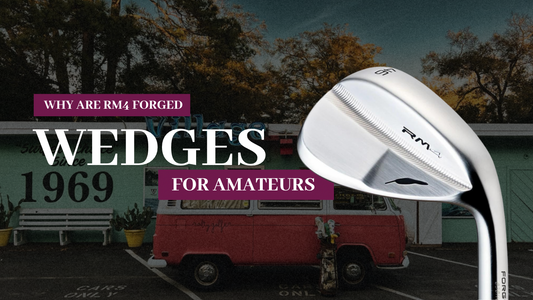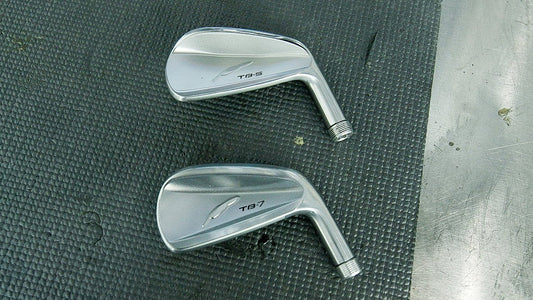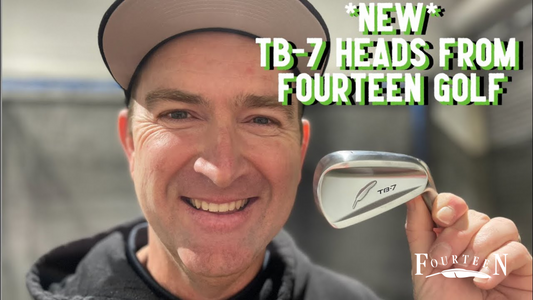How does one go from designing the first IMPREZA at SUBARU and JINS eyewear to designing cutting edge golf equipment? Fourteen spoke with Akira Teshima, lead designer for the new RM-4 wedge, about his design process and career journey.
The new RM-4 wedge is equipped with a high-precision finish in every detail and a new concept "Step Blade". The ideal image of performance envisioned by Head of Development, Mr. Hiroyuki Suzuki, and major influence of the PGA Tour support team, was shaped as a club design by Mr. Teshima.

Akira Teshima worked on the design of SUBARU and the first IMPREZA, and after designing and planning and developing furniture at PLUS, established Teshima Design Studio. Automobile related, eyewear, daily necessities, there are a wide variety of design targets, from industrial design such as medical equipment to branding.
Mr. Teshima teamed with Fourteen 14 years ago. At that time, Takamitsu Takebayashi (founder), who was looking for an excellent industrial designer that matched the feeling of Fourteen's products, contacted Mr. Teshima, who won the Good Design Award for automobile aluminum wheels. It was also the fateful timing for Mr. Teshima to become independent.

Mr. Teshima started designing the first IMPREZA (WRC three consecutive victories) at SUBARU, and then designed high-performance automobile parts and JINS eyewear. He is one of the best at expressing "functionality" and "texture" that touch the target user as the beauty of the form.
"The aesthetic of Fourteen's club design that I learned from Mr. Takebayashi is" not to follow the trends. " Twelve years ago, an athlete iron called "TC-1000" made my debut, but at that time I worked on the design while exploring what it was like Fourteen. However, Mr. Takebayashi gave me some freedom, saying, "You have to express your uniqueness." In the world view of Fourteen that I feel, the product logo design like never before was adopted, and the most "unlikely" one among many candidates was adopted, which is the basis of the guideline for me to proceed I think it became. However, if all the proposals are too “unlikely”, the feeling of Fourteen that the user has will be spoiled. The first thing I suggested was the independence of the feathers in the brand logo. "

"If you can make it a symbol that you can see at a glance as Fourteen by looking at the wings, you create a simpler and more sophisticated design."
As for the wedge design that Mr. Teshima worked on, the shocking thing was the "reverse taper blade" that was shaped 10 years ago. Mr. Teshima, who had an idea for devising a top blade as an industrial design, brings it to Fourteen to confirm the functional basis.
At that time, the prototype of the "reverse taper blade" was created in agreement with the development department, which was planning a new function to make the top blade thicker by the square groove regulation and stabilize the vertical behavior of the head.

"The policy I learned from Mr. Takebayashi, about the aesthetics of Fourteen, is to convey the performance at a glance by looking at the pictures, the design needs to evoke that. "
The "reverse taper blade" has a thick top blade, which symbolizes the strength of the upper and lower hit points against blurring. In addition, the blade part has been effectively step-designed so that the thickness does not matter when you hold it. There is no doubt that the fact that Fourteen has become a symbol of wedge function so much that other manufacturers have modeled this design is the result of Fourteen's excellent development ability to shape new things without being particular about existing ones.
Mr. Teshima, who will always miss Takebayashi, who passed away eight years ago, has teamed up with various developers to design the club. Although the thinking of the person in charge has changed, he emphasizes that Takebayashi Ism will be inherited as a corporate policy and the fundamentals will not change.
As if to prove it, the new work RM-4 equipped with "Step Blade" was created by overturning the existing one.
"When I conceived the RM-4, the theme was to evolve the reverse taper blade. The absolute theme was to dispel the familiarity and tiredness of both Fourteen, who came up with it, and users who have used it habitually. Then, based on the functional basis, we came up with a design that combines a new "step blade" with a change in thickness in the toe-heel direction. In addition, CNC processing is applied to the central recess and the thinnest part, but that method has already been adopted by other manufacturers, and users will have a sense of déjà vu.
As a Fourteen-like device, I was particular about designing diagonally in search of beauty when exposed to light. It is a very difficult method in terms of manufacturing technology, but Fourteen makes it possible without compromise even if it is impossible to force the manufacturing factory."

The RM-4 wedge has a functional feel and is simply sophisticated like Fourteen. Mr. Teshima's design technology, which has worked on the expression of functionality and texture and the beauty of form in various genres of industrial design, and the world view that expresses newness to Fourteen's pursuit are wonderful.
"If you feel that way from the user's point of view, I feel that the days of hard work have come to the fore. It's like Fourteen to think about the unexpectedness that delights the fans even though it's simple. The "RM-4" has become the most difficult model in my Fourteen design history, having matured the design many times with clear limits in terms of manufacturing technology, taking more time than previous products. I did.”
Learn even more about the RM-4 Development.






